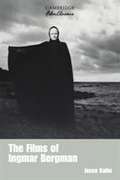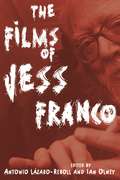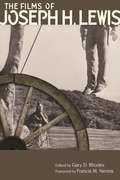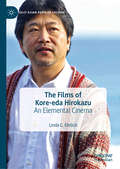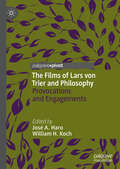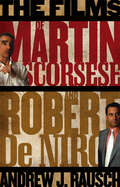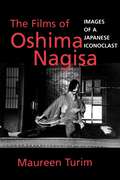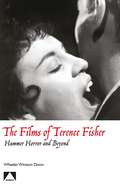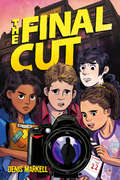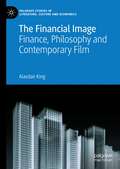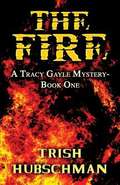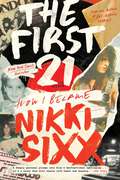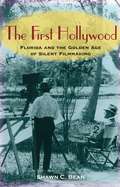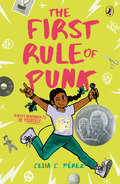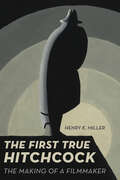- Table View
- List View
The Films of Ingmar Bergman (Cambridge Film Classics Series)
by Jesse KalinThis volume provides a concise overview of the career of one of the modern masters of world cinema. Jesse Kalin defines Bergman's conception of the human condition as a struggle to find meaning in life as it is played out. For Bergman, meaning is achieved independently of any moral absolute and is the result of a process of self-examination. Six existential themes are explored repeatedly in Bergman's films: judgment, abandonment, suffering, shame, a visionary picture, and above all, turning toward or away from others. Kalin examines how Bergman examines these themes cinematically, through close analysis of eight films: well known favorites such as Wild Strawberries, The Seventh Seal, Smiles of a Summer Night, and Fanny and Alexander; and important but lesser known works, such as Naked Night, Shame, Cries and Whispers, and Scenes from a Marriage.
The Films of Jess Franco (Contemporary Approaches to Film and Media Series)
by Ian Olney Antonio Lázaro-Reboll Dr Alberto Brodesco Professor Will Dodson Finley Freibert Professor Xavier Mendik Professor Tatjana Pavlovic Professor Vicente Rodríguez Ortega Professor Rubén Romero Santos Professor Nicholas G. Schlegel Aurore Spiers Dr Glenn Ward Dr Andy WillisThe Films of Jess Francolooks at the work of Jesús "Jess" Franco (1930–2013), one of the most prolific and madly inventive filmmakers in the history of cinema. He is best known as the director of jazzy, erotically charged horror movies featuring mad scientists, lesbian vampires, and women in prison, but he also dabbled in a multitude of genres from comedy to science fiction to pornography. Although he built his career in the ghetto of low-budget exploitation cinema, he managed to create a body of work that is deeply personal, frequently political, and surprisingly poetic. Editors Antonio Lázaro-Reboll and Ian Olney have assembled a team of scholars to examine Franco’s offbeat films, which command an international cult following and have developed a more mainstream audience in recent years. Arguing that his multifaceted, paradoxical cinema cannot be pinned down by any one single approach, this edited volume features twelve original essays on Franco’s movies written from a variety of different perspectives. The Films of Jess Franco does not avoid the methodologies most commonly used in the past to analyze Franco’s work—auteur criticism, genre criticism, and cult film criticism—yet it does show how Franco’s films complicate these critical approaches. This volume opens up fresh avenues for academic inquiry by considering his oeuvre from a range of viewpoints, including transnational film studies, cinephilia studies, and star studies. The book effectively meets the challenge of Franco’s multidimensional cinema with multifaceted criticism—attentive to the shifting historical contexts, modes of production and consumption, and formats of Franco’s work—that supplements current Franco scholarship and suggests exciting new directions for its further development. The Films of Jess Franco seeks to address the scholarly neglect of this legendary cult director and to broaden the conversation around the director’s work in ways that will be of interest to fans and academics alike.
The Films of Joseph H. Lewis (Contemporary Approaches To Film And Media Ser.)
by Francis M. Nevins Gary D. RhodesJoseph H. Lewis enjoyed a monumental career in many genres, including film noir and B-movies (with the East Side Kids) as well as an extensive and often overlooked TV career. In The Films of Joseph H. Lewis, editor Gary D. Rhodes, PhD. gathers notable scholars from around the globe to examine the full range of Lewis's career. While some studies analyze Lewis's work in different areas, others focus on particular films, ranging from poverty row fare to westerns and "television films." Overall, this collection offers fresh perspectives on Lewis as an auteur, a director responsible for individually unique works as well as a sustained and coherent style.Essays in part 1 investigate the texts and contexts that were important to Lewis's film and television career, as contributors explore his innovative visual style and themes in both mediums. Contributors to part 2 present an array of essays on specific films, including Lewis's remarkable and prescient Invisible Ghost and other notable films My Name Is Julia Ross, So Dark the Night, and The Big Combo. Part 3 presents an extended case study of Lewis's most famous and-arguably-most important work, Gun Crazy. Contributors take three distinct approaches to the film: in the context of its genre as film noir and modernist and postmodernist film; in its relationship to masculinity and masochism; and in terms of ethos and ethics.The Films of Joseph H. Lewis offers a thorough assessment of Lewis's career and also provides insight into film and television making in the 1930s, 40s, and 50s. Scholars of film and television studies and fans of Lewis's work will appreciate this comprehensive collection.
The Films of Kore-eda Hirokazu: An Elemental Cinema (East Asian Popular Culture)
by Linda C. EhrlichThe Films of Kore-eda Hirokazu: An Elemental Cinema draws readers into the first 13 feature films and 5 of the documentaries of award-winning Japanese film director Kore-eda Hirokazu. With his recent top prize at the Cannes Film Festival for Shoplifters, Kore-eda is arguably Japan’s greatest living director with an international viewership. He approaches difficult subjects (child abandonment, suicide, marginality) with a realistic and compassionate eye.The lyrical tone of the writing of Japanese film scholar Linda C. Ehrlich perfectly complements the understated, yet powerful, tone of the films. From An Elemental Cinema, readers will gain a special understanding of Kore-eda’s films through a novel connection to the natural elements as reflected in Japanese traditional aesthetics.An Elemental Cinema presents Kore-eda’s oeuvre as a connected whole with overarching thematic concerns, despite frequent generic experimentation. It also offers an example of how the poetics of cinema can be practiced in writing, as well as on the screen, and helps readers understand the films of this contemporary director as works of art that relate to their own lives.
The Films of Lars von Trier and Philosophy: Provocations and Engagements
by José A. Haro William H. KochThe films of Lars von Trier offer unique opportunities for thinking deeply about how Philosophy and Cinema speak to one another. The book addresses von Trier’s films in order of their release. The earlier chapters discuss his Golden Heart trilogy and USA: Land of Opportunities series by addressing issues of potential misogyny, ethical critique, and racial justice. The later chapters focus on his Depression Trilogy and address the undermining of gender binaries, the psychoanalytic meaning of the sacrifice of children and depression, and philosophical questions provoked by the depiction of the end of the world. Taken together, the volume explores the topics of Philosophical Psychology, Social Theory, Political Theory, Theories of the Self, Philosophy of Race, and Feminist Thought, and opens a conversation about von Trier’s important work.
The Films of Martin Scorsese and Robert De Niro
by Andrew J RauschIn 1973, early in their careers, Martin Scorsese and Robert De Niro collaborated for the first time. Over the next few decades, they worked together on seven more movies, many of which brought them both acclaim and awards. And while successful director and actor pairings have occurred throughout the history of film, few have fashioned so many works of enduring value as these two artists. In little more than two decades, Scorsese and De Niro produced eight features, including the classics Taxi Driver, Raging Bull, and GoodFellas. In The Films of Martin Scorsese and Robert De Niro, Andrew J. Rausch examines the creative output of this remarkable pair, from their initial offering, Mean Streets, to their most recent film together, Casino. Rausch looks at their relationship as individual artists who worked together to create cinematic magic, as well as the friendship that was forged nearly 40 years ago. Drawing upon interviews and other sources, Rausch goes behind the scenes of their eight films, providing insi
The Films of Mike Leigh
by Ray Carney Leonard QuartThe Films of Mike Leigh is the first critical study of one of the most important and eccentric directors of British independent filmmaking. Although active since 1971, Leigh has only come to the attention of an international audience in the 1990s through films such as Secrets and Lies and Career Girls. Like Robert Altman and John Cassevetes, Leigh works improvisationally, beginning with a small group of actors around whom he builds his films during months of private rehearsal. The script is written during this process. Ray Carney examines Leigh's working method and films in the intellectual and social contexts in which they were created. He argues that Leigh cannot be simply considered within the British realist tradition of Osborne and Loach. All of Leigh's major box office successes, including Naked, Life is Sweet and High Hopes, are analyzed, interpreted, and shown to be among the finest examples of cinema.
The Films of Mira Nair: Diaspora Verite
by Amardeep SinghThe Films of Mira Nair: Diaspora Vérité presents the first, full-length scholarly study of her cinema. Mira Nair has broken new ground as both a feminist filmmaker and an Indian filmmaker. Several of her works, especially those related to the South Asian diaspora, have been influential around the globe. Amardeep Singh delves into the complexities of Nair’s films from 1981 to 2016, offering critical commentary on all of Nair’s major works, including her early documentary projects as well as shorts. The subtitle, “diaspora vérité,” alludes to Singh’s primary theme: Nair’s filmmaking project is driven aesthetically by her background in the documentary realist tradition (cinéma vérité) and thematically by her interest in the lives of migrants and diasporic populations. Mainly, Nair’s filmmaking intends to document imaginatively the experiences of diasporic communities.Nair’s focus on the diasporic appears in the long list of her films that have explored the subject, such as Mississippi Masala, So Far from India, Monsoon Wedding, The Perez Family, My Own Country, The Namesake, and The Reluctant Fundamentalist. However, a version of the diasporic sensibility also emerges even in films with an apparently different scope, such as Nair’s adaptation of Thackeray’s Vanity Fair.Nair began her career as a documentary filmmaker in the early 1980s. While Nair now has largely moved away from the documentary format in favor of making fictional feature films, Singh shows that a documentary realist style remains active in her subsequent fictional cinema.
The Films of Orson Welles
by Charles HighamThis title is part of UC Press's Voices Revived program, which commemorates University of California Press’s mission to seek out and cultivate the brightest minds and give them voice, reach, and impact. Drawing on a backlist dating to 1893, Voices Revived makes high-quality, peer-reviewed scholarship accessible once again using print-on-demand technology. This title was originally published in 1970.This title is part of UC Press's Voices Revived program, which commemorates University of California Press’s mission to seek out and cultivate the brightest minds and give them voice, reach, and impact. Drawing on a backlist dating to 1893, Voices Revived</DIV
The Films of Oshima Nagisa: Images of a Japanese Iconoclast
by Maureen TurimThis study of the films of Oshima Nagisa is both an essential introduction to the work of a major postwar director of Japanese cinema and a theoretical exploration of strategies of filmic style. For almost forty years, Oshima has produced provocative films that have received wide distribution and international acclaim. Formally innovative as well as socially daring, they provide a running commentary, direct and indirect, on the cultural and political tensions of postwar Japan. Best known today for his controversial films In the Realm of the Senses and The Empire of Passion, Oshima engages issues of sexuality and power, domination and identity, which Maureen Turim explores in relation to psychoanalytic and postmodern theory. The films' complex representation of women in Japanese society receives detailed and careful scrutiny, as does their political engagement with the Japanese student movement, postwar anti-American sentiments, and critiques of Stalinist tendencies of the Left. Turim also considers Oshima's surprising comedies, his experimentation with Brechtian and avant-garde theatricality as well as reflexive textuality, and his essayist documentaries in this look at an artist's gifted and vital attempt to put his will on film.
The Films of Terence Fisher: Hammer Horror and Beyond (Auteur Ser. #No. 26)
by Wheeler Winston DixonTracing the entire career of the British director Terence Fisher, best known for his Gothic horror films for Hammer—such as The Curse of Frankenstein (1957) and Dracula (1958)—The Films of Terence Fisher covers not only his horror films, but also his film noirs, comedies, and early apprenticeship work to create a full picture of Fisher's life and work.Brimming with rare stills, interviews, and detailed analysis of Fisher's films—both for Hammer as well as his earlier work—this is the ultimate "one-stop" book on Terence Fisher, both in his horror films, and his entire body of work, as well as his legacy to the British cinema.
The Films of Werner Herzog: Between Mirage and History (Routledge Library Editions: Cinema)
by Timothy CorriganGiven Herzog’s own pronouncement that ‘film is not the art of scholars, but of illiterates,’ it is not surprising that his work has aroused ambivalent and contradictory responses. Visually and philosophically ambitious and at the same time provocatively eccentric, Herzog’s films have been greeted equally by extreme adulation and extreme condemnation. Even as Herzog’s rebellious images have gained him a reputation as a master of the German New Wave, he has been attacked for indulging in a romantic naiveté and wilful self-absorption. To his hardest critics, Herzog’s films appear as little more than Hollywood fantasies disguised as high seriousness. This book is an attempt to illuminate these contradictions. It gathers essays that focus from a variety of angles on Herzog and his work. The contributors move beyond the myths of Herzog to investigate the merits of his work and its place in film history. A challenging range of films is covered, from Fata Morgana and Aguirre, the Wrath of God to more recent features such as Nosferatu and Where the Green Ants Dream, offering the reader ways of understanding why, whatever the controversies surrounding Herzog and his films, he remains a major and popular international filmmaker. Orignally published in 1986.
The Final Cut
by Denis MarkellAn hilarious coming-of-age story about home, friendship, and learning that sometimes the most exciting adventures happen behind-the-scenes. Alex Davis is convinced that seventh grade is going to be his year. After spending all summer at skate camp, he knows he&’ll finally be seen as one of the &“cool kids&” . . . until he&’s mistakenly put in the wrong elective. Now, instead of taking a popular video games class with his friends, he&’s stuck in Filmmaking with hipster teacher Pablo and a group of eccentric classmates. But when it&’s announced that their films will be entered in the school&’s annual Golden Reel competition, Alex becomes determined to claim first prize and salvage his seventh-grade year. With the help of his longtime crush, his best friend, and a peculiar new student, Alex sets out to make a masterpiece. Soon he discovers that someone is trying to sabotage his film and finds himself embroiled in a mystery—one that leads him and his crew to conniving classmates, traitorous teachers, and even corrupt city politicians!
The Final Rewrite: How to View Your Screenplay with a Film Editor’s Eye
by John RosenbergThis book offers a unique perspective on crafting your screenplay from an editor’s point-of-view. Special features include before and after examples from preproduction scripts to post production final cuts, giving screenwriters an opportunity to understand how their screenplay is visualized in post production. By the time a script reaches the editing room, it has passed through many hands and undergone many changes. The producer, production designer, director, cinematographer, and actor have all influenced the process before it gets to the editor’s hands. Few scripts can withstand the careful scrutiny of the editing room. This book reveals how to develop a script that will retain its original vision and intent under the harsh light of the editing console. It provides insights that writers (as well as producers and directors) need and editors can provide for a safe journey from the printed page to the final release. This book is ideal for aspiring and early career screenwriters, as well as filmmakers and established screenwriters who want to gain a better understanding of the editing process.
The Final Years of Marilyn Monroe: The True Story
by Keith BadmanThis “extraordinary” account of the superstar’s tragic death, and what led up to it, is “a relentless and detailed quest for the truth” (Lancashire Post).In his illuminating, fascinating book, Keith Badman finally uncovers the truth about the iconic actress’s last years. It was a tough time—one in which Marilyn Monroe’s increasingly erratic behavior and dependence on alcohol and medication plunged her glittering movie career into drastic decline. Meticulously researched, the book reveals precisely how Monroe died at just thirty-six years of age, and shines a light on the suspicious delays on the night of her overdose—delays that indicate a cover-up. He discovers new details about her rekindled relationship with Joe DiMaggio, and the horrendous weekend she spent at Frank Sinatra’s Cal-Neva lodge, as well as why Fox refused to let her finish her final movie, Something’s Got to Give, and her distress at being imprisoned at the Payne Whitney psychiatric hospital.Drawing on private, previously unpublished itineraries and original eyewitness accounts, Badman sheds new light on Marilyn’s involvement with John and Bobby Kennedy, and ends a six-decade-old mystery by telling the precise date of her first encounter with the president. The Final Years of Marilyn Monroe features a deluge of stories of which even die-hard fans will be unaware.“[A] nearly day-by-day account of her life from June 1961 to her death in August 1962.” —Kirkus ReviewsIncludes photos
The Financial Image: Finance, Philosophy and Contemporary Film (Palgrave Studies in Literature, Culture and Economics)
by Alasdair KingThe Financial Image: Finance, Philosophy, and Contemporary Film draws on a broad range of narrative feature films, documentaries, and moving image installations in the US, Europe, and Asia. Using frameworks from contemporary philosophy and critical finance studies, the book explores how contemporary cinema has registered recent financial and economic issues. The book focuses on how filmmakers have found formal means to explore, celebrate, and critique the increasingly important role that the financial sector plays in shaping global economic, political, ethical, and social life.
The Fire (A Tracy Gayle Mystery #1)
by Trish HubschmanThe band "Tidalwave" had their tour bus set ablaze. Long Island PI, Tracy Gayle, is hired as the band's security chief as a cover for her to do some snooping. The culprit might be amongst the troupe. Eventually, the arsonist does come to light, but there's an even bigger threat, to the band leader's life. Nobody has any idea of the danger that's lurking for Danny Tide. In June 2014, Trish saw the classic rock band, Styx, in concert on Long Island. A few days later, while the band was on break in Philadelphia, their tour bus unexpectedly burst into flames. Trish researched the matter, trying to discover what actually happened. Unable to find anything solid out, she created her own mystery story surrounding it.
The First 21: How I Became Nikki Sixx
by Nikki SixxRock-and-roll icon and three-time bestselling author Nikki Sixx tells his origin story: how Frank Feranna became Nikki Sixx, chronicling his fascinating journey from irrepressible Idaho farmboy to the man who formed the revolutionary rock group Mötley Crüe. <P><P> Nikki Sixx is one of the most respected, recognizable, and entrepreneurial icons in the music industry. As the founder of Mötley Crüe, who is now in his twenty-first year of sobriety, Sixx is incredibly passionate about his craft and wonderfully open about his life in rock and roll, and as a person of the world. Born Franklin Carlton Feranna on December 11, 1958, young Frankie was abandoned by his father and partly raised by his mother, a woman who was ahead of her time but deeply troubled. Frankie ended up living with his grandparents, bouncing from farm to farm and state to state. He was an all-American kid—hunting, fishing, chasing girls, and playing football—but underneath it all, there was a burning desire for more, and that more was music. He eventually took a Greyhound bound for Hollywood. <P><P> In Los Angeles, Frank lived with his aunt and his uncle—the president of Capitol Records—for a short time. But there was no easy path to the top. He was soon on his own. There were dead-end jobs: dipping circuit boards, clerking at liquor and record stores, selling used light bulbs, and hustling to survive. But at night, Frank honed his craft, joining Sister, a band formed by fellow hard-rock veteran Blackie Lawless, and formed a group of his own: London, the precursor of Mötley Crüe. <P><P> Turning down an offer to join Randy Rhoads’s band, Frank changed his name to Nikki London, Nikki Nine, and, finally, Nikki Sixx. Like Huck Finn with a stolen guitar, he had a vision: a group that combined punk, glam, and hard rock into the biggest, most theatrical and irresistible package the world had ever seen. With hard work, passion, and some luck, the vision manifested in reality—and this is a profound true story finding identity, of how Frank Feranna became Nikki Sixx. It's also a road map to the ways you can overcome anything, and achieve all of your goals, if only you put your mind to it. <P><P><b>A New York Times Best Seller</b>
The First Cut
by Nancy KrulikThe students at the school aspire to be stars. When Eileen Kerr, a renowned talent agent, comes to town in search of her next hit girl band, the young women of PCBS realize how close they are to reaching their dreams. Only four girls will be chosen.
The First Hollywood: Florida and the Golden Age of Silent Filmmaking
by Shawn C BeanFlorida Book Awards, Gold Medal for Florida NonfictionInside the filmmaking industry in Jacksonville before the rise of HollywoodJacksonville, Florida, was the center of the infant film industry. Devastated by fire in 1901, rebuilt in a wide variety of architectural styles, sharing the same geographic and meteorological DNA as southern California, the city was an ideal location for northern film production companies looking to relocate.In 1908, New York-based Kalem Studios sent its first crew to Jacksonville. By 1914, fifteen major companies—including Fox and Metro Pictures—had set up shop there. Oliver Hardy, D. W. Griffith, Mary Pickford, and the Barrymores all made movies in the Florida sunshine. In total, nearly 300 films, including the first Technicolor picture ever made, were completed in Jacksonville by 1928.But the city couldn't escape its past. Even as upstart Hollywood boosters sought to discredit Jacksonville, the city's influence diminished from a combination of political upheaval, simmering racial tensions, disease, and World War I. Shawn Bean uses first-person accounts, filmmaker biographies, newspaper reports, and city and museum archives to bring to light a little-known aspect of film history. Filled with intrigue, backroom shenanigans, and missed opportunities, The First Hollywood is just the kind of drama we've come to expect from the big screen.
The First King of Hollywood: The Life of Douglas Fairbanks
by Tracey GoesselThe complete, definitive biography of Hollywood's first superstar Douglas Fairbanks was the greatest leading man of his generation--the first and the best of the swashbucklers. He made some of the greatest films of the silent era, including The Thief of Bagdad, Robin Hood, and The Mark of Zorro. With Charlie Chaplin, D. W. Griffith, and his wife, film star Mary Pickford, he founded United Artists. Pickford and Fairbanks ruled Hollywood as its first king and queen for a decade. Now a cache of newly discovered love letters from Fairbanks to Pickford form the centerpiece of the first truly definitive biography of Hollywood's first king, the original Robin Hood, the true Zorro, the man who did his own stunts, built his own studio, and formed a company that allowed artists to distribute their own wealth outside the studio system. Fairbanks was fun, witty, engaging, creative, athletic, and a force to be reckoned with. He shaped our idea of the Hollywood hero, and it has never been the same since. His story, like his movies, is full of passion, bravado, and romance.
The First Rule of Punk
by Celia C. PérezFrom debut author and longtime zine-maker Celia C. Pérez, The First Rule of Punk is a wry and heartfelt exploration of friendship, finding your place, and learning to rock out like no one’s watching. <P><P>There are no shortcuts to surviving your first day at a new school—you can’t fix it with duct tape like you would your Chuck Taylors. <P><P>On Day One, twelve-year-old Malú (María Luisa, if you want to annoy her) inadvertently upsets Posada Middle School’s queen bee, violates the school’s dress code with her punk rock look, and disappoints her college-professor mom in the process. <P>Her dad, who now lives a thousand miles away, says things will get better as long as she remembers the first rule of punk: be yourself. <P>The real Malú loves rock music, skateboarding, zines, and Soyrizo (hold the cilantro, please). <P>And when she assembles a group of like-minded misfits at school and starts a band, Malú finally begins to feel at home. <P>She'll do anything to preserve this, which includes standing up to an anti-punk school administration to fight for her right to express herself! <P><P>Black and white illustrations and collage art throughout make The First Rule of Punk a perfect pick for fans of books like Roller Girl and online magazines like Rookie.
The First Ten Pages (How to Adapt Your Novel Into a Screenplay #4)
by Frank CatalanoHOW TO HAVE A STRONG OPENING FOR YOUR SCREENPLAY SO THEY WILL READ IT TO THE END. THE FIRST TEN PAGES was first presented as part of the 25th Annual Writer's Conference sponsored by San Diego State University on February 6 through the 8th, 2009 at the Double Tree Hilton Hotel in Mission Hills, California. The following transcript was presented and recorded by Frank Catalano as part of the programs offered at the conference. The book ibased partly upon that presentation, focuses on the adaptation of an existing novel into a screenplay for presentation as a motion picture, television program or Internet content. Writers of fiction and non-fiction and industry professionals from the publishing business primarily attended the 25th Annual Writer's Conference. Mr. Catalano's seminars focused upon those writers seeking to adapt their novels into screenplays. The complete list of seminar presentations by Frank Catalano for this conference is: BOOK 1: WRITE GREAT CHARACTERS IN THE FIRST TEN PAGES BOOK 2: WRITING ON YOUR FEET - IMPROVISATIONAL TECHNIQUES FOR WRITERS - Part 1 BOOK 3: START YOUR STORY AT THE END BOOK 4: THE FIRST TEN PAGES BOOK 5: BOOK TO SCREEN BOOK 6: ACTING IT OUT - IMPROVISATIONAL TECHNIQUES FOR WRITERS - Part 2 BOOK 7: WRITE GREAT DIALOGUE
The First Time: Finding Myself and Looking for Love on Reality TV
by Colton UnderwoodFrom former football player and star of The Bachelor and The Bachelorette comes a fascinating and eye-opening behind-the-scenes look at his drama-filled season on the hit reality show. <P><P>Before Colton Underwood captured the hearts of millions on The Bachelor, he was a goofy, socially awkward, overweight adolescent who succeeded on the football field while struggling with personal insecurities off it. An All American gridiron hero, he was also a complex, sometimes confused, soft-hearted romantic wondering how these contradictions fit together. <P><P> Old-fashioned and out of step with the swipe right dating culture of today, he was saving the most intimate part of life for the love of his life. If only he could find her… <P><P>Now, in The First Time, Colton opens up about how he came to find himself and true love at the same time via the Bachelor franchise. Unencumbered by cameras and commercial breaks, he delivers a surprisingly raw, endearing, and seriously juicy account of his journey through The Bachelorette, Bachelor in Paradise, and The Bachelor, along with what has happened with him and Cassie Randolph since his season wrapped. <P><P>He opens up about being dumped by Becca, his secret dalliance with Tia, what it was like to be the world’s most famous virgin, his behind-the-scenes conflicts with production, and how his on-camera responsibilities as the Bachelor nearly destroyed him after he knew he had already fallen in love with Cassie. <P><P>A memoir for Bachelor Nation and anyone who believes in the magic of love, The First Time carries a simple but powerful message: It’s okay to laugh and cry and occasionally jump over a fence, if it means coming one step closer to the right person. <P><P><b> A New York Times Bestseller</b>
The First True Hitchcock: The Making of a Filmmaker
by Henry K. MillerHitchcock’s previously untold origin story.Alfred Hitchcock called The Lodger "the first true Hitchcock movie," the one that anticipated all the others. And yet the story of how The Lodger came to be made is shrouded in myth, often repeated and much embellished, even by Hitchcock himself. The First True Hitchcock focuses on the twelve-month period that encompassed The Lodger's production in 1926 and release in 1927, presenting a new picture of this pivotal year in Hitchcock's life and in the wider film world. Using fresh archival discoveries, Henry K. Miller situates Hitchcock's formation as a director against the backdrop of a continent shattered by war and confronted with the looming presence of a new superpower, the United States, and its most visible export—film. The previously untold story of The Lodger's making in the London fog—and attempted remaking in the Los Angeles sun—is the story of how Hitchcock became Hitchcock.
